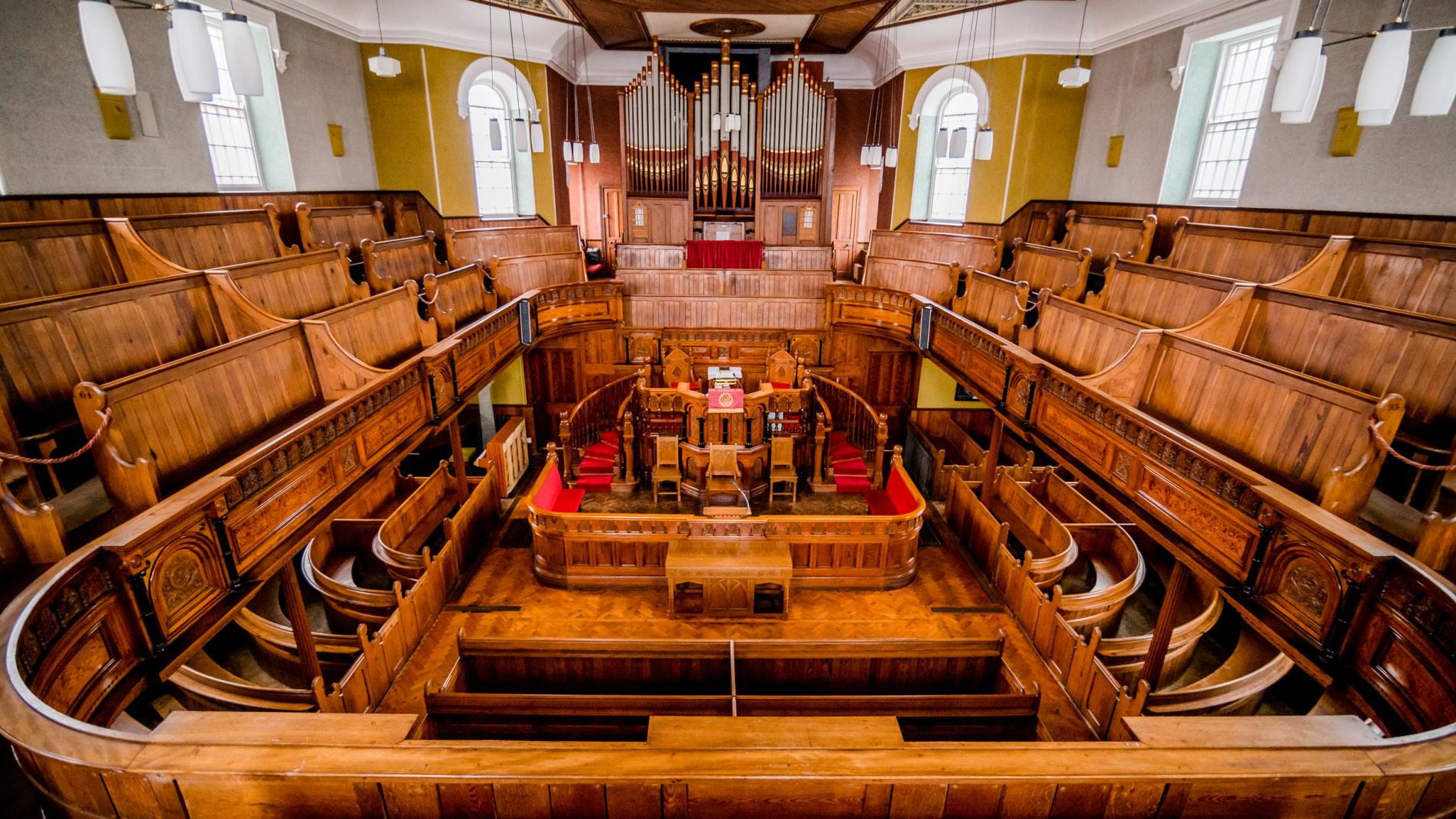
Visit historic buildings along Lion Street. This is the 4th stop in WALK: The Brecon Story, our heritage trail around Brecon.
Plough Chapel
We turn around now to walk up Lion Street, the narrower and initially uninviting lane ( as it was once called) that parallels the Bulwark and embraces so much of Brecon’s history. On the right is the Plough Chapel (plaque 8), which dates back to the earliest days of the nonconformist movement. The first worshippers gathered here in 1699 in a meeting room of a pub on this site, called the ‘Plow House’. The present building dates back to 1841 with substantial remodelling in 1892. The interior houses a magnificent collection of carved wood architecture and late Victorian design. It was called ‘one of the prettiest chapels in the whole of the Principality’ with the cost put at upwards of £2,500.
Lion Street
A few steps away we find 4 Lion Street (plaque 9), a grand brick built townhouse dating, it’s thought, to the mid 18th century. The ornate ironwork and lamp of the front gate hint at past wealth. In 1881 it boasted of drawing and dining room furniture in Italian Walnut and Spanish mahogany. By the end of the decade though the household was looking for ‘a good servant with knowledge of plain cooking.’
Next door, we have more grandeur with Cantre’ Selyf (plaque 10), a late 17th century home with substantial reworking in the early 19th century. Its name (a modern addition?) echoes the medieval name for this part of the ancient Lordship of Brycheiniog.
Beyond and Lion Yard, on the right, leads to the Visit Brecon offices and a large supermarket on the site of the old farmers market. Staying on Lion Street, to the rear of the Guildhall an arched walkway takes us into Bethel Square. Look out for the plaque (plaque 11) on the right which tells the story of the Golden Lion pub which stood here - and the coaches which ran from here to London, Merthyr, Hereford and Milford Haven. It had clearly been a very profitable business. One newspaper of 1743 reported that the then keeper, Thomas Palfrey had ‘acquired a Fortune of upwards of Five Thousand Pounds’ by the time he passed away. A newspaper advert from November 1806 boasted of ‘Cheap and Expeditious Travelling’ on the ‘New Telegraph Post Coach’. But a local historian reports a charge of one shilling and three pence per mile - at a time when labourers were paid only around eight shillings a week.
The Brecknockshire Agricultural Society was founded here by a group of 16 or 17 local landowners in March 1755. Originally intended to be a hunting club it quickly transformed into a group supporting good farming practices. It’s now the oldest surviving agricultural society in the UK. Beyond the arch stands the former Bethel Calvinistic Methodist Chapel, built in the grounds of the Golden Lion. It was opened in 1853 at a cost of £1,350 with seating for some 800 people.
We continue along Lion Street and more plaques and signs of the town’s illustrious past. Church House (plaque 12) is a Grade II* Listed late 16th or early 17th century L-plan townhouse with an early 18th century facade onto Lion Street. Look up and you will see the most ornately carved decoration under the overhanging roof. These are officially described as “richly carved eaves cornice with modillions and egg and dart on ovolo moulding.” If you step through the arched alleyway, a 17th century or earlier timber framed rear wing appears with an overhanging first floor hiding under the pebbledash. Beyond that, in the corner of the courtyard, part of the building has been restored to offer an insight into its full glory.
Number 12 Lion Street (plaque / stone 13) was the home of Theophilus Jones (1759-1812), author of the History of the County of Brecknock, published 1805-1809 and still regularly consulted by historians today. Jones went to our local Christ College before working as a lawyer and then taking a Church job - giving him more time for his research. He was first Master of the Loyal Brecknock Lodge of Freemasons. His history may still be in regular use over 200 years later but Theophilus is said to have “lost upward of £400 in the undertaking.” Whisper it quietly but there were complaints of “innumerable mistakes” in the books. One keen supporter, though, pointed out that Theophilus was suffering disabling gout and would have corrected the mistakes with a second edition.
Lion Street is part of our WALK: The Brecon Story heritage trail. Click here to access the Google Earth map or visit the next place on our trail